CRF300L Index page
Previously on 300L Tubeless Wheels
Tubeless Wheel Conversion Index page
Note: I rushed this job below and had a manageable slow leak from the 17, a meltdown on the 19 front arriving in hot Marrakech (fitted a tube), but the 21 I left at home has held its air fine for months. In Marrakech the mechanic re-sealed the rear in between my trips, cleaning then applying a continuous band of Puraflex. He’s doing the same to my 19 front. Summary: technique works if you take your time – days of curing – and do it right.
Note: I rushed this job
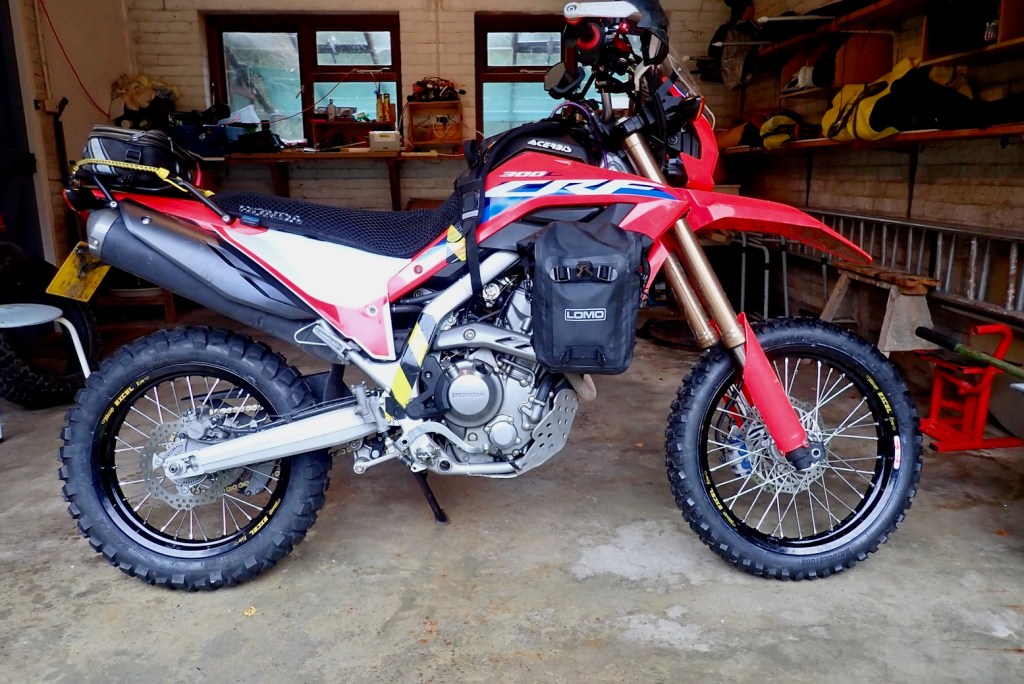
It took so long to get my three new tubeless wheels made I’d forgotten quite why I did it. Oh, yes, the clear desirability of tubelessness, plus some experimentation with wheel sizes, notably a 19-er front which is 38mm less tall, 7mm wider and the same weight as the stock tubed wheel. Wheel builders seem to have long lead times, rims are not in stock, custom spokes need to be made and holiday needs to be taken. Once everything was in place and my slot came up, the actual job took a couple of days.
The Fly & Ride transporter was leaving for Malaga next week so I had to get cracking. Ideally I’ve have had a month or more to sort any sealing issues and get a feel for the new sizes.
The 19-inch wheel arrived so I got stuck in but rushed it. I didn’t wait a day for the glue to cure, then fatally used slippery 303 UV Protectant to help mount the very stiff AX41. Works great on tubed wheels but I suspected it was a bad idea for MYO tubeless. Once mounted, when I spotted 303 bubbling out of a spoke thread I knew the game was up.
With the tyre off, my glue blobs had gone soft (left, from 303 contact?) and peeled off like soggy plasters. To be fair, one problem with this used 19-inch rim was that the pre-existent spoke holes (from a KTM?) had to be reamed and re-angled to fit the Honda hub. It made for bigger gaps so I tried to seal the outside of the nipples with Stormsure where water might run in, but should have done a better job all round.
This is the gamble of marrying pre-drilled rims with non-matching hubs. Angle-wise, there can’t be that much in it, but in this case it was enough to misalign the pull of the spokes. Some wheel builders like CWC keep drilling patterns or templates to precisely drill a rim to match a given hub. This used Excel rim saved me £150 which I easily paid back with re-drilling and custom spokes. Oh well, the perils of experimentation.
Next day I needed to get my ducks in a row. Typically for me, I wasn’t repeating the proven system from the Africa Twin, but trying a new idea suggested by a mate. I spent a couple of hours in Poole sourcing components and by the time I got back, the other two wheels had arrived. After cleaning the 303 off yesterday’s mess, I started over.








Spray the rims’ well with etching primer. Halfords were out so I paid £21 down the road. All for 60 secs of spraying ;-/ I presume the idea is the sealant sticks better to the primer than the glossy black rim.

Individual blobs as opposed to a continuous band like here are better for isolating leaks, as will soon be shown. But a continuous band ought to mean a guaranteed and complete seal. Decisions, decisions.

Next day I felt fairly confident I’d sealed all three wheels but had some heavy tyre wrangling to do. Sod it I thought, why not support the local economy and let my LBS mount the tyres. They’ll have a tyre machine and a compressor with enough poke to shove the tubeless tyres onto the bead before they know what’s happening.
With 30 quid well spent, the tyres came out the shop rock hard. But would they stay that way? No, the two fronts were losing air. Casting aside seal damage during mounting, what were the chances of 104 blobs and 3 valves all being perfectly sealed? Only about 98% it seems. I turned the leaking wheels slowly through a trough of water and isolated a leaking spoke on each. I marked the spokes and whipped off the tyres, much easier now they’d been pre-flexed at the shop.

On the 19er I spotted a millimeter wide hole in the Puraflex (left) which the dab of Superglue underneath had also not sealed. I’ve not used Puraflex before – it’s not like a bathroom sealant and is PU, not silicon, based. Not sure what that means – the stuff was good and hard but had shrunk a bit as it dried. Perhaps the hole had opened up on curing, or perhaps I should have inspected each blob with a magnifying glass or given them all a pre-emptive second swipe of Puraflex once dried – that would take another day to dry. On the 21 incher I couldn’t see the hole under the corresponding spoke’s blob which underlines the idea of a second coat or even a continuous band. So I second-coated all the blobs and left it for another night. Weeks later the 21 (left at home) had lost just a couple of pounds so I’ll take that as a win.
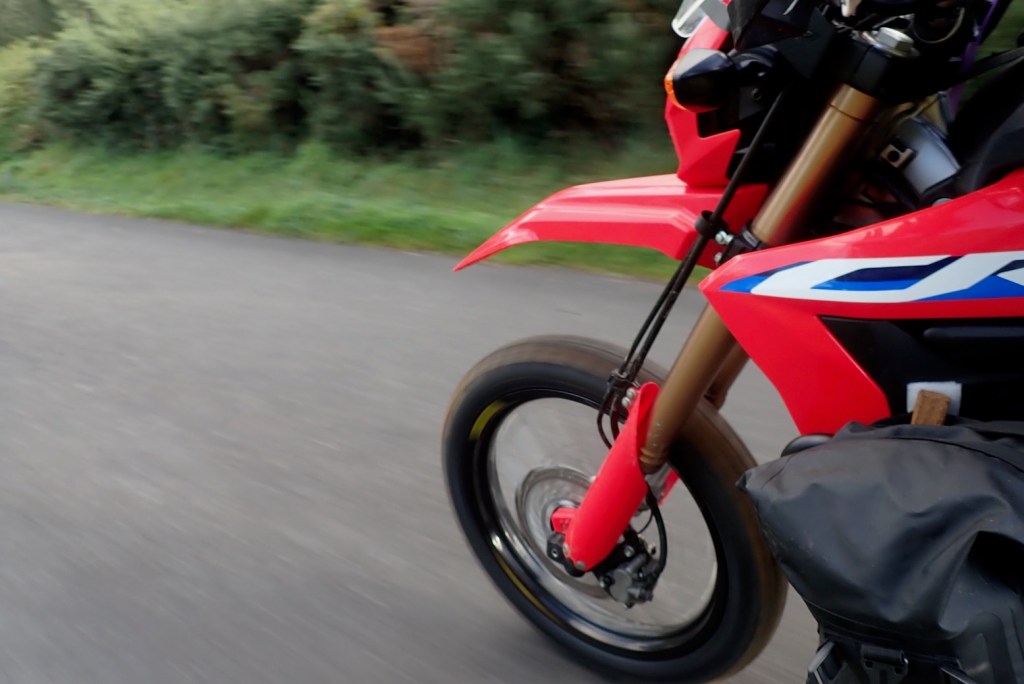

All bolted on and first thing I noticed was the bike leant the same on the side stand, so clearly was no lower. Not that bothered as it’s one less thing to meddle with and the narrow saddle means my feet touch down OK. I guess the AX41s have high sidewalls; good for off-road and rim protection.
I went for a lovely evening ride. On the road the fresh tyres didn’t exhibit any anomalies, nor did the handling feel much different. I think it might take a more spirited ride through some bends to highlight any improvements in the steering. In Morocco I know just the spot, several in fact. The 19 is only 7mm wider than the 21, while the back 17-incher is the same as the stock IRC.

In Halfords I’d bought some Slime for later, but also carefully applied a shot of similar Tru-Tension tyre sealant (left) in the front wheel, squeezing it up into the valve set at 12 o’clock so it would dribble down along the rim’s well. This stuff contains ‘carbon fibre and graphene’ which are such cutting edge compounds I fell for it. Slime or similar have helped permanently seal other imperfect MYO TL jobbies, even though it shouldn’t be necessary if the job has been done well.
I rode back to London and then on to Fly & Ride near Gatwick. Whatever fuel I picked up in Poole, the CRF (now with 2200 miles on the clock) belted along like it was on methanol, holding an indicated 70 much of the time. But both tyres were still losing a bit of overnight air so I may have to spend a day in Morocco sorting it all out. I’ve packed Puraflex, some more Slime and a pair of tubes and levers.

Robbo, a fellow MYO TL experimenter does wonder whether Slime etc can soften rim sealants. These goops work under pressure but also centrifugally, getting flung out onto the inside of the tyre where punctures occur, but away from the hand-sealed rim well where, in my case, it’s as needed.
Much as Sixties psychedelic guru Tim Leary proposed that enlightenment and self-awareness must eventually be sought without the aid of drugs, so MYO TL should endeavour to seal without Slime. Tune in. Glue Up. Ride out.


Robbo showed me a niffy USB rechargeable 4000MAH tyre pump (above right) which topped my overnight tyres up quickly. I have my aged 12-volt Cycle Pump packed on the bike, but if I’ll be topping up regularly until they’re fixed, the 20-quid hand pump off ebay will be easy to whip out and use each morning. Let’s make rumpy pumpies while the lithium lasts.
I left my 300 in Fly & Ride’s yard alongside a cool ’72 750SS Commando. The period image on the left exists solely to highlight Norton’s questionable use of an apostrophe. It turned out the nicely set up 300 Rally also parked up belonged to another Robbo who was on my tour a year ago and by now is halfway to Dakar, or however far suits him.
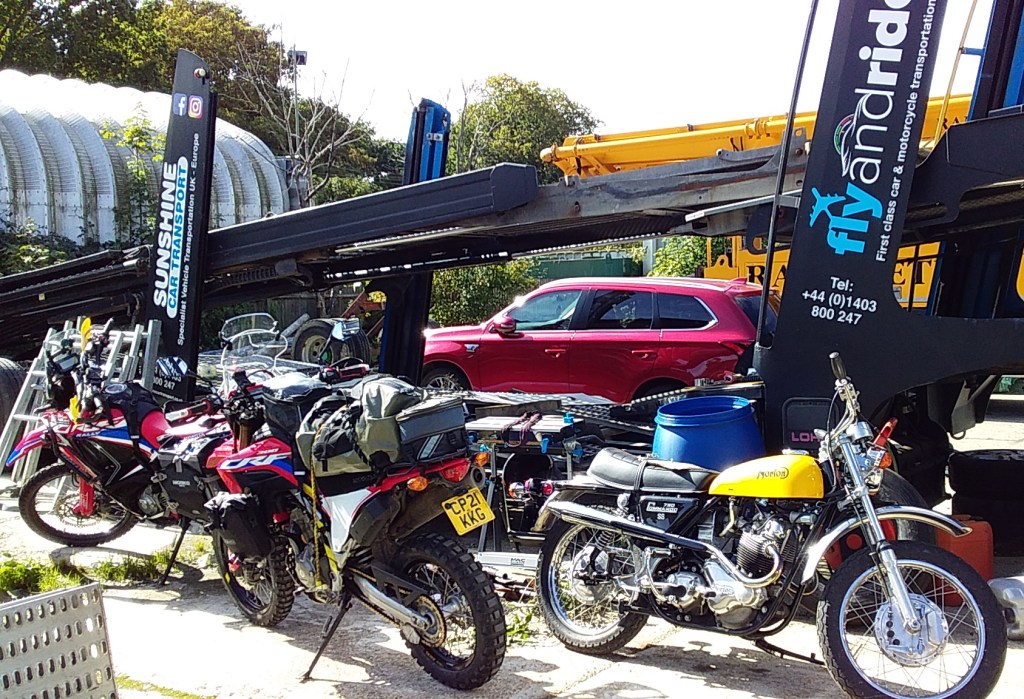
So, a bit annoying to be flying out to Malaga next week to imperfect wheels, but what trip ever kicks off without some T’s uncrossed and I’s undotted? At least I have the means to fix it.


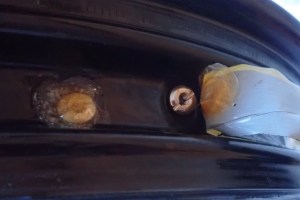
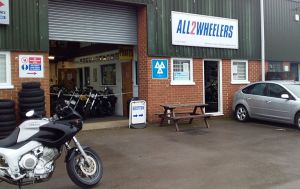



Brilliant pics and text thanks!!!
LikeLike
Chris, I have had 100% success rate with sealing three spoked rear wheels. My method is: 1. Quick rub over relevant areas with a Scotchbrite pad. 2. Degrease using clean paraffin then Isopropyl alcohol (or similar). 3. Treat spoke nipples with Captain Tolley’s Creeping Crack Cure. This seals up the fine paths any air leak would follow. It is more flexible than cured superglue.
Cover spoke nipples with 3M Marine Adhesive Sealant (5200). Let this cure for several days. 5. Apply a layer of 3M Extreme Sealing Tape (4411N), including at least 50mm of overlap.
Make a hole through the tape where the tubeless valve is to go and install the valve using silicon sealant. The tape is important as the sealant blobs are subject to high centripedal forces and can peel away if they are not well adhered and/or held by the tension and adhesion of the tape band. I am not convinced about dropping from 21-inch to 19-inch on a front wheel. I am convinced that the larger-diameter front wheel is one of the reasons my Africa Twin is much more controllable in challenging off-road conditions than my R1200GSs were.
All the best, Dave P.S. We are now back from the CDT / BDR trip. The CDT was brilliant and we managed to avoid forest fires, thunder storms, excessive heat and bears. Dan had a close encounter with a Bison but that was about as dangerous at it got.
LikeLiked by 1 person
Hi Dave & Dan, welcome back from CDT. Looking forward to your presentation at the Yuletide TRF Fancy Dress Gala. Perhaps you can some as a bison. Thanks for your TL tips. The not so secret secret is time and meticulous application. My 21 sealing appears to have worked, but good point about the tape constraining unwanted [don’t you mean?] centrifugal blob expulsion. I used 5200 on my very first TL MYO (XT660) but did a sloppy job and without Scotchbrite, Isopropyl and Captain Tolley’s Crack. All good info. Have a look at Patch & Go when the 4411 runs out.
Wrt 19s, I do admit it would make a giant adv less of a tank on the dirt (such as they can be), and I never read complaints about the AT’s 21 on the road. I expect to lose a bit of dirt agility with the 300’s 19, but on a 150-kilo bike I can give away 38mm less height, 7mm more width for the same weight. Will I notice any corresponding benefits swinging through the Atlas asphalt like Tarzan in a sharkskin mankini? We shall see but that’s why I got a 21 TL’d too. My 19 rationale has always been real world overlanding (80/20 road /dirt rideability). Shame I never had the chance to attempt a 19/21 comparison.
LikeLiked by 1 person
Chris, Reference centripetal [not centripedal, my typo] force versus centrifugal force. If you watched a spinning wheel and saw one of your blobs fly off, you might say that its flight was due to centrifugal force. However, this is not the case. Newton’s first law of motion states that a body will remain stationary or move with a constant velocity (i.e. in a straight line) unless acted upon by an external force. What your blob wants to do is move in a straight line with the same speed as the portion of wheel rim to which it is attached. However, the wheel rim has other ideas and is constantly pulling the blob in the direction of the centre of rotation. This pull is centripetal force. The blob therefore reluctantly moves in a circle. If, at any time, the centripetal force exceeds the adhesive force, the blob will break free and fly off, initially in a straight line tangential to the wheel rim surface. What the blob does after than is down to gravity and aerodynamic drag. A miss working as an engineer – can you tell? Dave
LikeLike
I thought you’d come uop with something like that ;-)
LikeLike
Have you tried (or anyone else for that matter) the mountain bike technology for ‘ghetto tubeless’ ?
LikeLike
Hi Chris, I seem to think this is a slang term used by J-Mo on Advrider, but isn’t it just what is being done above: DIY sealing and taping? Fyi, I bought some of that Muc-Off pink tape but soon saw it was too stiff and narrow to mold nicely into a moto’s well. I do wonder about the value of tape at all if the nipple sealing has been done well (if the tape gets hot it can fling off), but I’d sooner re-use the squidgier 3M 4411N tape I used on the AT.
LikeLike
I picked the phrase up from my MTB brethren. A lot of people used to use Gorilla tape before manufacturers came along and provided an ‘official’ tape and special fluid to seal both rim and puncture.
I had forgotten about the heat factor.
LikeLike
Gorilla is amazingly good and the regular stuff might be airtight for longer than I think, away from UV inside a tyre. On a wide rim, like the back of my AT, I bet you could just lay down a run of thick Gorilla Patch & Go which I use on packrafts for repairs/protection. Stickier than 4411, more stretchy and as impregnable. Would take just 10 mins but might need redoing once in a while.
There is a difference to doing all this for TRFing with your mates round the UK (when a tube repair would be a bit of a lunch break) vs riding alone out in Morocco and beyond. Someone recorded ’52°C’ on the Alg border last week. Almost certainly not in the shade, but with black rims and tyres rolling on gravel that’s too hot to walk on barefoot, the added effort of glued up or otherwise bonded spoke nipples is worth it.
LikeLike